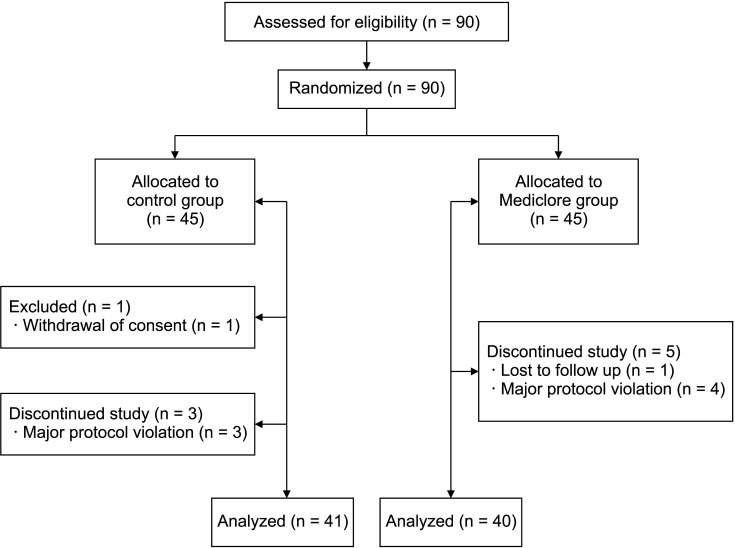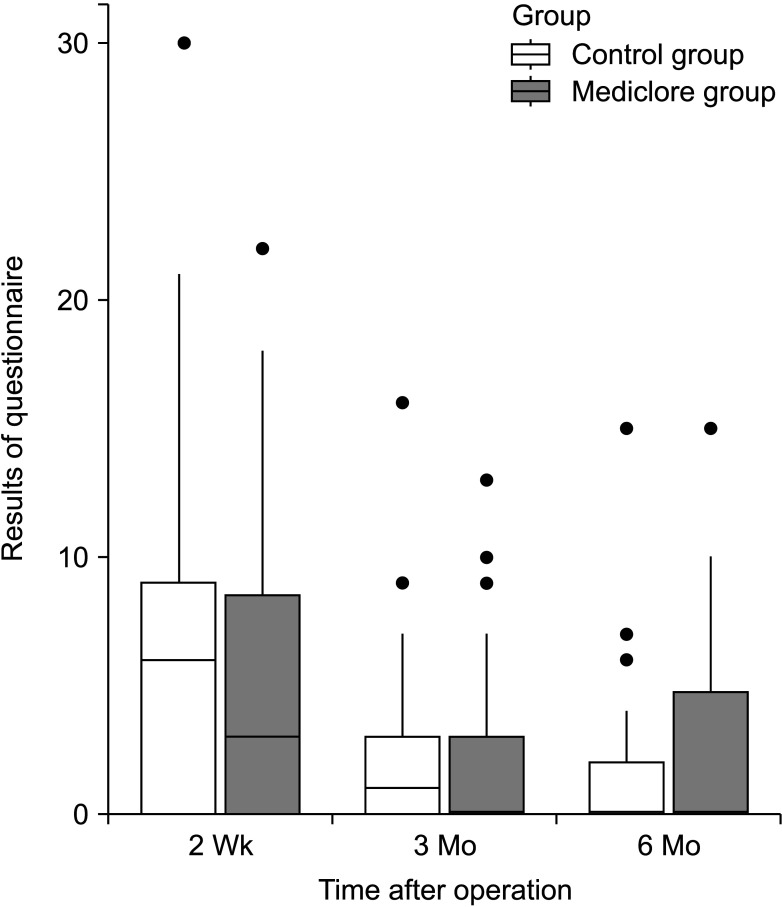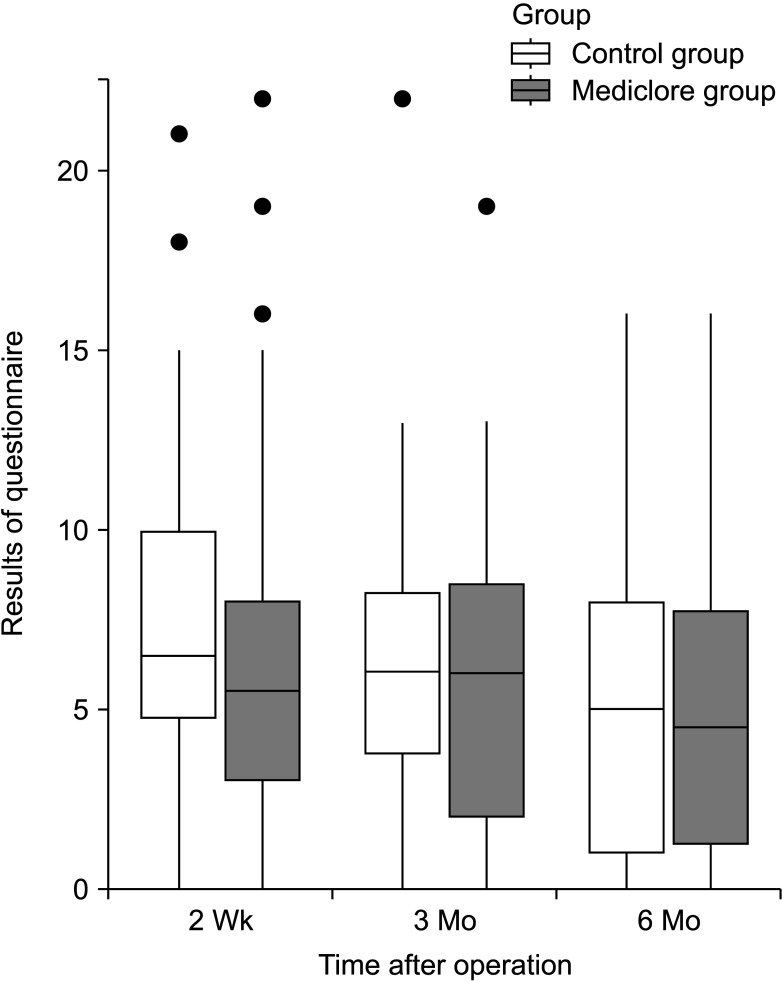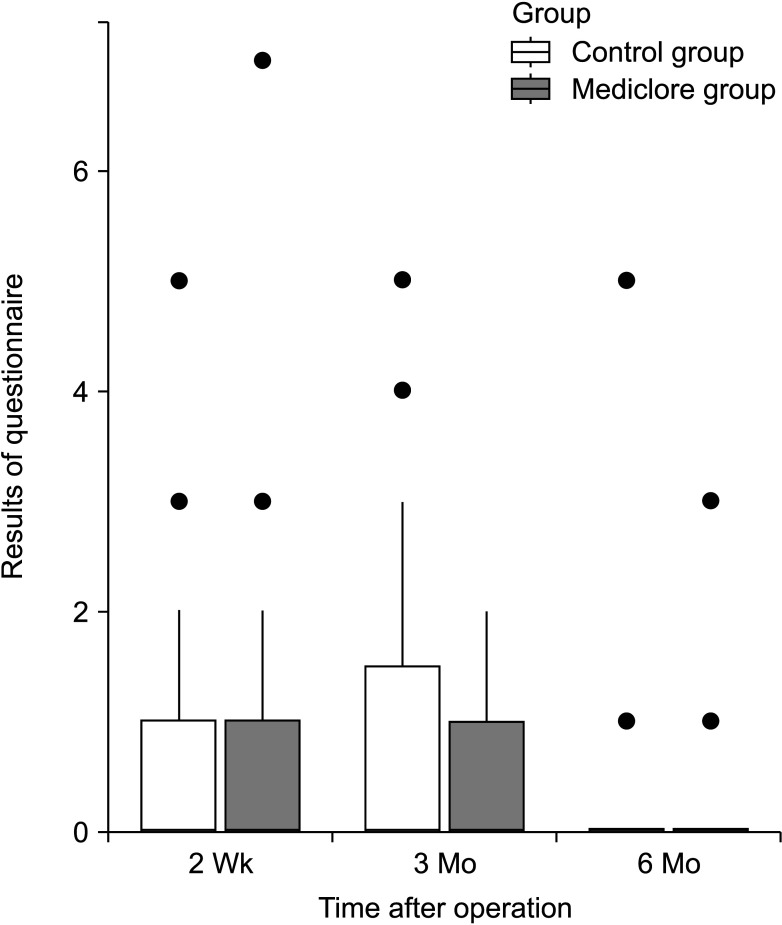Ann Surg Treat Res.
2022 Jun;102(6):313-322. 10.4174/astr.2022.102.6.313.
Anti-adhesive effect and safety of a thermosensitive adhesion barrier (Mediclore) for thyroid surgery: a double-blinded randomized controlled trial
- Affiliations
-
- 1Department of Surgery, Chungbuk National University Hospital, Cheongju, Korea
- 2Department of Surgery, lnha University College of Medicine, Incheon, Korea
- 3Department of Surgery, Seoul National University College of Medicine, Seoul, Korea
- 4Department of Surgery, Young Do Hospital, Busan, Korea
- 5Department of Surgery, lnha University Hospital, Incheon, Korea
- 6Department of Surgery, Seoul National University Hospital, Seoul, Korea
- 7Cancer Research Institute, Seoul National University College of Medicine, Seoul, Korea
- 8Integrated Major in Innovative Medical Science, Seoul National University Graduate School, Seoul, Korea
- KMID: 2530385
- DOI: http://doi.org/10.4174/astr.2022.102.6.313
Abstract
- Purpose
Postoperative adhesions after thyroidectomy adversely affect patients’ quality of life. This study assessed the anti-adhesive effect and safety of thermosensitive sol-gel agents for patients undergoing thyroidectomy.
Methods
A double-blind parallel-group randomized clinical trial involving patients aged 20–70 years undergoing thyroidectomy for thyroid nodules was conducted. From August 2017 to April 2020, 90 patients were randomly assigned to the experimental (n = 45, thermosensitive sol-gel agent applied to the surgical site) and control (n = 45, no treatment) groups in a 1:1 ratio. All patients were assessed using a questionnaire for swallowing difficulty, wrinkle problems, and inflammation at 2 weeks, 3 months, and 6 months after thyroid surgery. For reoperated patients, the degree of adhesion was evaluated according to the adhesion-evaluation score system (range, 0–4).
Results
During the follow-up period of 6.50 ± 1.38 months, the swallowing difficulty, wrinkle problem, and inflammation were improved in both groups. However, there was no statistically significant difference between the control and experimental groups related to swallowing difficulty, wrinkle problems, and inflammation. Two patients in the control group and 1 in the experimental group who underwent reoperation had an adhesion-evaluation score of 3 points. There were no adverse effects or allergic reactions.
Conclusion
A thermosensitive sol-gel agent can be safely used as an anti-adhesive barrier. However, this study did not reveal its efficacy for postoperative adhesions. A more objective and systematic study is required in the future.
Figure
Reference
-
1. Jung KW, Won YJ, Hong S, Kong HJ, Lee ES. Prediction of cancer incidence and mortality in Korea, 2020. Cancer Res Treat. 2020; 52:351–358. PMID: 32178488.
Article2. Thompson LD, Wieneke JA, Paal E, Frommelt RA, Adair CF, Heffess CS. A clinicopathologic study of minimally invasive follicular carcinoma of the thyroid gland with a review of the English literature. Cancer. 2001; 91:505–524. PMID: 11169933.
Article3. Mazzaferri EL, Young RL. Papillary thyroid carcinoma: a 10 year follow-up report of the impact of therapy in 576 patients. Am J Med. 1981; 70:511–518. PMID: 7211893.
Article4. Berber E, Bernet V, Fahey TJ 3rd, Kebebew E, Shaha A, Stack BC Jr, et al. American Thyroid Association statement on remote-access thyroid surgery. Thyroid. 2016; 26:331–337. PMID: 26858014.
Article5. Pan JH, Zhou H, Zhao XX, Ding H, Wei L, Qin L, et al. Robotic thyroidectomy versus conventional open thyroidectomy for thyroid cancer: a systematic review and meta-analysis. Surg Endosc. 2017; 31:3985–4001. PMID: 28337546.
Article6. Kim WY, Lee JB, Kim HY, Park PJ, Jung SP, Lee HY, et al. Prospective, randomized, double blind, multicenter study for an auto crosslinked polysaccharide gel to evaluate antiadhesive effect and safety compared to poloxamer/sodium alginate after thyroidectomy. Int Surg. 2019; 103:452–460.
Article7. Oh A. Trends of anti-adhesion adjuvant-review. Biomater Res. 2013; 17:138–145.8. Park WS, Chung YS, Lee KE, Kim HY, Choe JH, Koh SH, et al. Anti-adhesive effect and safety of sodium hyaluronate and sodium carboxymethyl cellulose solution in thyroid surgery. Asian J Surg. 2010; 33:25–30. PMID: 20497879.
Article9. Kim YI, Lee M, Kim SI, Seol A, Lee EJ, Kim HS, et al. A randomized controlled trial of thermo-sensitive sol-gel anti-adhesion agent after gynecologic surgery. J Clin Med. 2020; 9:2261.
Article10. Kim TI, Jung W, Chung JY, Jeong H, Kim SH. Effect of a poloxamer-based thermosensitive gel on rotator cuff repair in a rabbit model: a controlled laboratory study. J Orthop Surg Res. 2019; 14:190. PMID: 31238965.
Article11. Chung JH, Kim KS, Choi JD, Kim TH, Lee KS, Oh CY, et al. Effects of poloxamer-based thermo-sensitive sol-gel agent on urethral stricture after transurethral resection of the prostate for benign prostatic hyperplasia: a multicentre, single-blinded, randomised controlled trial. BJU Int. 2020; 125:160–167. PMID: 31444917.
Article12. Nam IC, Joo YH, Cho JH, Kim CS, Kim SY, Kim GJ, et al. Effects of an antiadhesive agent on functional recovery of the greater auricular nerve after parotidectomy: a double-blind randomized controlled trial. Eur Arch Otorhinolaryngol. 2019; 276:3185–3193. PMID: 31338575.
Article13. Bae DS, Woo JW, Paek SH, Kwon H, Chai YJ, Kim SJ, et al. Antiadhesive effect and safety of sodium hyaluronate-carboxymethyl cellulose membrane in thyroid surgery. J Korean Surg Soc. 2013; 85:199–204. PMID: 24266009.
Article14. Park KS, Lee KE, Ku do H, Kim SJ, Park WS, Kim HY, et al. Antiadhesive effect and safety of oxidized regenerated cellulose after thyroidectomy: a prospective, randomized controlled study. J Korean Surg Soc. 2013; 84:321–329. PMID: 23741689.
Article15. Fischer A, Koopmans T, Ramesh P, Christ S, Strunz M, Wannemacher J, et al. Post-surgical adhesions are triggered by calcium-dependent membrane bridges between mesothelial surfaces. Nat Commun. 2020; 11:3068. PMID: 32555155.
Article16. Choi GJ, Park HK, Kim DS, Lee D, Kang H. Effect of statins on experimental postoperative adhesion: a systematic review and meta-analysis. Sci Rep. 2018; 8:14754. PMID: 30283040.
Article17. Lee JS, Kim JP, Ryu JS, Woo SH. Effect of wound massage on neck discomfort and voice changes after thyroidectomy. Surgery. 2018; 164:965–971. PMID: 30054014.
Article18. Alkan Z, Yigit O, Adatepe T, Uzun N, Kocak I, Sunter V, et al. Effect of anti-adhesive barrier use on laryngotracheal movement after total thyroidectomy: an electrophysiological study. Indian J Otolaryngol Head Neck Surg. 2014; 66(Suppl 1):71–77. PMID: 24533362.
Article19. Yigit O, Uslu Coskun B, Coskun H, Yilmaz B, Alkan S, Cinar U, et al. Efficacy of anti-adhesive barriers in secondary thyroidectomy: an experimental study. Laryngoscope. 2004; 114:1668–1673. PMID: 15475802.
Article20. Kim DY, Kang SW, Kim DS, Shin JU, Chung WY, Park CS, et al. Preventive effect of human acellular dermal matrix on post-thyroidectomy scars and adhesions: a randomized, double-blinded, controlled trial. Dermatol Surg. 2015; 41:812–820. PMID: 26066615.
Article21. Andres Y, Giraud L, Gerente C, Le Cloirec P. Antibacterial effects of chitosan powder: mechanisms of action. Environ Technol. 2007; 28:1357–1363. PMID: 18341146.
Article22. Raafat D, von Bargen K, Haas A, Sahl HG. Insights into the mode of action of chitosan as an antibacterial compound. Appl Environ Microbiol. 2008; 74:3764–3773. PMID: 18456858.
Article23. Kim HK, Kim SM, Chang H, Chun KW, Kim BW, Lee YS, et al. Anti-adhesive agent (Guardix-SG®) does not influence the drainage volume after thyroid cancer surgery. Korean J Endocr Surg. 2013; 13:251.
Article24. Haugen BR, Alexander EK, Bible KC, Doherty GM, Mandel SJ, Nikiforov YE, et al. 2015 American Thyroid Association management guidelines for adult patients with thyroid nodules and differentiated thyroid cancer: the American Thyroid Association Guidelines Task Force on thyroid nodules and differentiated thyroid cancer. Thyroid. 2016; 26:1–133. PMID: 26462967.
Article
- Full Text Links
- Actions
-
Cited
- CITED
-
- Close
- Share
- Similar articles
-
- The safety and anti-adhesive effect of acellular dermal matrix application after thyroid surgery: a multicenter randomized controlled trial
- The Efficacy and Safety of Guardix-SG® in Patients Who Are Undergoing Thyroid Surgery: A Randomized, Prospective, Double-blinded Study
- Anti-Adhesive Effect of GUARDIX-SL(R) after Intact Canal Wall Mastoidectomy: Preliminary Study
- Sporopollenin-based material for prevention of postoperative adhesions: a murine study
- Efficacy of Roflumilast in Bronchiectasis Patients with Frequent Exacerbations: A Double-Blinded, Randomized, Placebo-Controlled Pilot Clinical Trial





